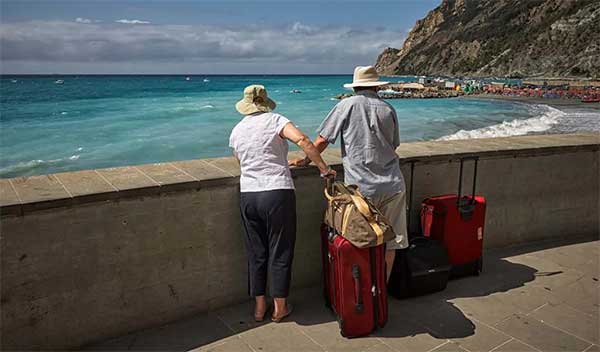
As 70-year-old San Francisco-based Homer prepares for his yearly trip to Manila to meet Philippine-based family members and devour his favorite kare-kare, he joins over 137 million[1] 60+ travelers worldwide, many of whom journey each year to reconnect with loved ones and rediscover the comforts of home.
With seniors now accounting for a significant share of long-haul travel driven by more time, disposable income, and a deep desire to reconnect, senior VFR voyagers are now redefining its landscape.
According to the latest data from Trevolution Group, the share of Visiting Friends and Relatives (VFR) travel has surged significantly in recent years, particularly among senior travelers. Since early 2020, the demand has been growing steadily, with a major increase in the 65+ age group, while from 2021 to 2023, this momentum showed over double the increase.
Although they usually don’t engage in typical tourist activities and most likely remain in a single location within the destination country, VFR travelers can still be a significant boost to their hometown economy.
This type of travel, often labelled as “leisure”, is the most resilient and accounts for up to 48% of global tourists, and the numbers are only growing, only this segment has been underappreciated, and the industry often falls short of meeting the needs of mature globetrotters. Some call the VFR “a sleeping giant” of the travel industry.
The Call Matters—Meet Homer
For Homer, booking his trips starts with a phone call because, as he says, “things are easier this way.”
“I don’t trust screens,” Homer explains. “Back in the day, we didn’t talk to computers—we talked to people. And I insist on keeping it that way.”
This pretty much sums up the expectations of 65+ travelers: the simpler, the better.
While younger generations may easily book their trips online and navigate through complex itineraries, getting fascinated by being able to get all the necessary info from an AI-powered travel chatbot, older travelers, who are typically less tech-savvy or do not know foreign languages, prefer to book through traditional channels such as call-to-book travel agencies, opting for non-stop flights without layovers that offer a higher level of comfort and convenience.
Or in Homer’s case, as he says, “This is less time-consuming and more in-depth. With screens—you push the wrong button, and bam—everything’s gone. I prefer to have a real conversation, and we can fit it together if something goes wrong.”
The fear of screwing up might be one of the biggest motivators to discuss the complicated itineraries with an experienced, live travel agent— and most companies are shying away from serving 65+ audiences and target youngsters instead.
As a result, 65+ globetrotters are often left underserved, and many airlines and OTAs still fall short of meeting their needs.
The solution? Smarter, more inclusive travel experiences—think easy-to-navigate online platforms that offer comprehensive, real human assistance with booking and services that address medical and security concerns. Not only does this make the journey smoother for seniors, but it also opens untapped revenue for brands bold enough to truly cater to the 65+ crowd.
Handle with Care
Vivencia, a 79-year-old retired chemist who frequently flies from New York to Pampanga, doesn’t book flights based on price or perks—she chooses travel deals that include reliable baggage handling.
“I like to be in control. When I solo-travel, which is very often, I am always asked if I am not afraid of getting lost in large airports or if I am not scared of missing a flight— not at all. But I get terrified by the thought of losing my check-in bag, filled with gifts for my family members and medications. For me, this is a dealbreaker.”
In fact, many in this demographic are less concerned about the long-haul flights but more concerned about the security of their travel plans, particularly when it comes to potential baggage loss.
Vivencia is not alone – there are millions of travelers around the globe who fear the same. One traveler recalls the panic of navigating unclear COVID-related restrictions during a layover, while another one now always insists on guaranteed wheelchair access between flights after a missed long-haul flight connection left them stranded.
For older travelers, clarity, accessibility, and peace of mind aren’t nice-to-haves—they’re non-negotiables. In fact, Trevolution Group reports a 236% increase in demand for lost baggage protection and general travel insurance for travelers in the 65+ age group from 2023 to 2024.
Unfortunately, many travel care providers are still struggling to tailor their policies to meet the unique needs of an older demographic of travelers, and issues like pre-existing medical conditions, the need for personal assistance, and concerns about accessibility and mobility are often overlooked.
Not only travel providers but also airlines and airports alike need to ensure their facilities are equipped to meet these needs by providing accessible seating, wheelchair assistance, and easy-to-follow instructions for those with reduced mobility. Better yet, if adjustments were made under a unified set of service standards followed globally, so that older travelers would know exactly what to expect, ensuring consistency and reliability across the board.
Fasten Your Takeaways
Contrary to what many believe, VFR seniors aren’t looking for luxury— what they seek is human contact, assurance that “it will be alright”, and a stress-free service (or one very close to that).
Can the industry do better? For sure it can. Are the changes easy to implement? Unfortunately, not.
But as demand for VFR continues to rise, the entire industry has an opportunity to create a more inclusive and sustainable ecosystem.
The ageing global population is expected to drive significant growth in the emerging VFR travel segment, with more elderly travelers seeking to reconnect with loved ones across borders. By embracing its potential, we can foster stronger connections between travelers and the destinations they visit, support local economies, and encourage responsible travel practices. It’s time to recognize that the VFR traveler, often seen as a secondary market, is and will continue to be a vital driver of the global tourism economy.
In the currently stagnating travel market, where all niches seem saturated and younger, price-conscious travelers become more ready to sacrifice their comfort for economy, the overlooked segment of 60+ travelers could present a new area of growth. (Photo from https://hanapphonline.com/senior-friendly-travel-destinations/)
[1] https://fastercapital.com/content/Elderly-travel-and-tourism-Silver-Adventures–How-Elderly-Travelers-Are-Boosting-the-Tourism-Industry.html?utm_source=chatgpt.com






















